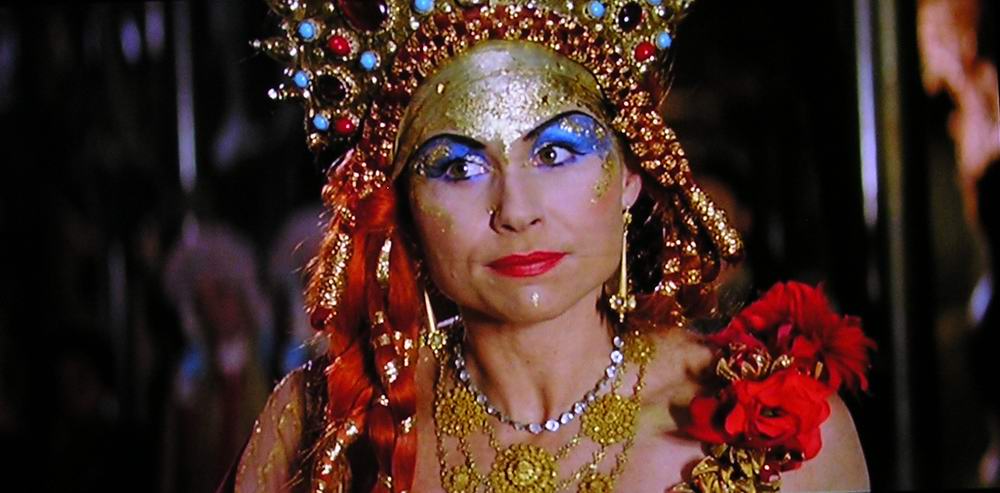In this section I'll focus first on how well the Epson Cinema 400 does handling flesh tones, then black levels/shadow detail and overall color balance. Toward the bottom though, I'm going to kick the Cinema 400 out of its best modes (I primarily viewed movies in Theater Black 1 mode, and look at what it offers when you need a lot more lumens, for dealing with ambient light, or simply to view things, where you don't want the room really dark (like a nice football game).
I am impressed with the overall image quality of the Cinema 400. I'm going to try not to make too many comparisons here, to the older Cinema 550 it replaces, but some are in order.
So, let's get those out of the way. I found the older projector to be a bit soft when viewing content, regardless of the input resolution. We're talking subtle here, the Cinema 550 was, however, sharper than the Panasonic PT-AE900u with its "smooth screen" lcd's which reduced the visibility of the pixel structure, but added softness.
In talking with Epson, I was not able to solidly determine why I found the Cinema 400 to be sharper, but here's what Epson told me. The Cinema 400 uses newer, better LCD panels called D5+ instead of the old D5, so that, likely had much to do with it. Also, of note, the Cinema 400 (like the 550) uses a dynamic iris to enhance contrast, but the Cinema 400's contrast is rated 5000:1 instead of 3000:1, and the improved contrast, no doubt gives you the feel of a sharper image. Perhaps the key change is in the optics themselves, Epson said there are "improvements to the multi-lens array". The newer Cinema 400 also uses an improved lamp. Epson also tweaked the positioning of the panels, thus changing the light path slightly.
Enough speculation. Let's consider the end result - how did the Cinema 400 projector perform?
Let me start by saying I found the default color settings need a little work, out of the box, although, they were acceptable without tweaking. (I would recommend using a basic "end user" calibration disk, easy enough to do, even for those not inclined to fool with adjustments.) Although the out of box color accuracy isn't bad at all, it's not as good as some other projectors, either. I was in a rush when testing, with less time than usual due to leaving on a family vacation, so I didn't spend quite as much time calibrating. (I usually have a projector for about a week, in this case, though, only 2+ days.) I did, however, end up with an excellent picture - color wise, although a bit more tweaking should have further eliminated the tendency for warmer color handling (reds, etc.) when measuring brighter areas (gray calibration) , and a shift toward cooler temperature in the dark grays.
Click here to enlarge. Let's talk flesh tones, always the first (and in my opinion, most important test of color). If a projector screws up flesh tones, everyone is immediately unhappy.
I found both the Gandalf and Arwen (above) images to be really excellent, with good tonal balance, and especially rich colors without appearing oversaturated!
 Click Image to Enlarge
Click Image to EnlargeLastly is the image of Nancy, from Sin City, a movie using little in the way of color (a dark movie with much appearing to be black and white, but with subtle sepia-like shading, and occasional splashes of color. Impressed yet? Of course the world (or some parts of it) are going Hi-Def, so check out this image from Phantom of the Opera, from my Toshiba HD-DVD player.
Click for a larger version. (Both images are just a touch dark, unintended.) The Epson Cinema 400 has a dynamic iris, to improve contrast and black levels. This is common on many new home theater projectors, especially LCD models, as they inherently can't match the contrast/black levels of DLP projectors. The Cinema 400 claims an increase of contrast from 3000:1 to 5000:1.
 Click Image to Enlarge
Click Image to EnlargeThe very good news is that the dynamic iris is subtle, in normal viewing I never noticed its affect, as I have on some projectors, where frame by frame, the addition of a bright object in the frame causes even the dark areas to brighten.
When it comes to black levels - getting those intended blacks as dark gray as possible, the Epson performed reasonably well, but, let's say, it isn't the great strength of the Cinema 400. The Cinema 400 offers a lot of control of white and black levels, and I played with them briefly, but this projector is not going to get you as black a black as the better under $2000 DLP projectors. On outer space scenes, though, it did perform well, achieving pretty good blacks, plenty of stars and a good amount of depth for a low cost projector. (I guess you just can't have everything in a $1600 projector - big surprise).



